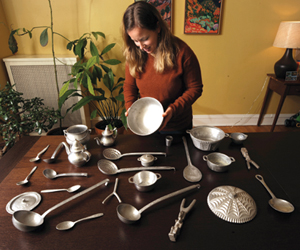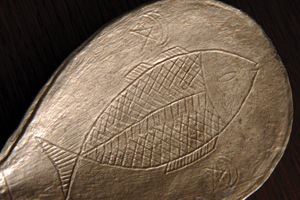Source material
Historian Emily Osborn reads the story of modern-day West Africa in ordinary aluminum pots and pans.
By Elizabeth Station
Photography by by Dan Dry
Not every historian discovers links to the past in a dusty attic or a quiet archive. Emily Lynn Osborn found original sources for her latest long-term project on a crowded street joining city markets in Kankan, eastern Guinea. On a summer day in 2001, during a research trip to West Africa, the assistant professor of history noticed a storefront where men were polishing shiny teapots. Nearby she saw giant stacks of newly made aluminum pots, lids, and spoons. “I had two of these pots at home,” says Osborn. “There’s not a household in West Africa that doesn’t have at least one locally made, cast-aluminum pot.” Although she had seen the cookware everywhere from restaurants to open-air cooking fires, she had no idea where it came from.

Cast-aluminum cookware, ubiquitous in West African households, gives Osborn a glimpse of the informal economy there.
The realization was small but significant for Osborn, who studied African history as an undergraduate at the University of California, Berkeley, and as a doctoral student at Stanford. She had researched three centuries of political and social change in eastern Guinea for a book, Making States: Power, Gender, and Colonial Rule in Kankan-Baté, West Africa, 1650–1920 (forthcoming, Ohio University Press).
Relying heavily on oral sources for that project, Osborn had developed an extensive network of contacts among the region’s Maninka Mori people. When she mentioned her new interest in aluminum cookware to a friend in Kankan, he introduced her to a group of artisans who produced pots, pans, and mechanical parts for the nearby market.
Osborn visited a workshop and watched the men melt down locally purchased scrap aluminum over oil-drum fires, pour it into handmade sand molds, and recycle it into cookware. She interviewed an older artisan about when and where he had learned his trade. His answer pointed her toward a theory that subsequent research would confirm: the history of aluminum casting could be traced through several decades of masters and apprentices. Requiring few raw materials but considerable skill, the practice originated in Dakar, Senegal, during World War II. As Senegalese casters and their trainees migrated, it spread quickly through West and Central Africa.
For a scholar who documents change through the stories of living people, aluminum casting “turned out to be quite an extraordinary topic,” says Osborn. Returning in late 2001 to the University of Notre Dame—where she taught before coming to Chicago in 2007—she found “virtually nothing” on the subject. Historians had concentrated on Africa’s wage labor and formal-sector employment and the effect of “epic technologies” such as railroads, roads, and bridges. But they had overlooked everyday innovations like aluminum casting, which does not require financial investment, electricity, or running water and is managed and disseminated informally by small-scale producers.
The project stayed on the back burner until 2005, when a sabbatical allowed Osborn 11 months of field research in Guinea, Senegal, Mali, Sierra Leone, Côte d’Ivoire, and Gambia. One of her first discoveries, she wrote in the journal African Identities last year, was that “aluminum is a 20th-century metal, and its story in Africa, as it is most everywhere else in the world, is a 20th-century one.” Because aluminum casting went from being rare to commonplace in less than 50 years, masters and apprentices provided for the future of their own profession while constituting “a living archive” of its past.
Although the trade she studies is exclusively male, Osborn’s interest in women—and what she calls “the material transformations of everyday life”—helped lead her to it. During interviews for her book on Kankan-Baté (the precolonial Islamic state of which Kankan was the capital), Osborn had found women who spoke knowledgeably about precolonial history. Yet others often reacted to her political questions by laughing and waving her toward a male leader. Conversations about cooking, childrearing, and household management, areas where women felt comfortable claiming expertise, came more easily.

Skilled artisans, casters decorate their work.
When the subject was pots and pans, “I could go virtually anywhere and talk to people about it,” says Osborn. “Women may not remember precisely when some political event took place, but if you ask older women when they got their first aluminum cooking pot, they remember.” Before then, a few women could afford imported cast-iron cookware, but the vast majority stocked their kitchens with locally made pottery. Aluminum offered immediate advantages: durable and lightweight, it conducts heat well and can be made into big pots, so women can cook large volumes of food at once.
Interviewing women adds “specificity and precision” to male accounts, Osborn adds. Discussions often included “vivid descriptions” of changes to their own material existence that coincided with aluminum casting’s postwar arrival: the advent of mosquito nets, Western medicine, and imported luxury goods—events that altered health standards and produced new markers of wealth.
Aluminum casting offered an entry point for Osborn to chart the rise of West Africa’s informal economy, a segment not measured as part of any country’s gross national product. She plans to write a book, tentatively titled “Recycling Traditions: Aluminum Casting and the Making of a Modern African Diaspora.” National boundaries and ethnic and linguistic differences didn’t hinder the transfer of this technology. Osborn hopes to provide “a transnational perspective” that previous historians may have missed with their tendency to focus their analyses on a particular colony or nation-state.
Preferring a hands-on approach to more conventional research methodologies, Osborn did a three-month apprenticeship in a Kankan aluminum-casting workshop, finishing pots under the watchful eye of a master caster. “When you do archival research, you can have a productive day as long as the archives are open and the archivist will give you documents.” For her a productive day might mean talking with people in rural villages and city neighborhoods. Although she speaks French, Malinke, and “a little Wolof,” Osborn enlists local research assistants to translate. So far the six-country aluminum study has involved 12 languages.
As a research topic, cast-aluminum cookware exposes a paradox. Guinea sits on roughly one-third of the world’s bauxite reserves—the raw material for aluminum—yet most of the bauxite mined there is exported and made into aluminum products in the United States, Europe, and Asia. Foreign companies manufacture Heineken cans, window frames, and auto parts and then import them to West Africa. When they become scrap, casters recycle them into new goods and capture some of the returns.
For Osborn, this “great conundrum” is partly what draws her to the research. “West Africa is home to some of the poorest countries in the world, and yet it’s one of the most culturally rich places as well,” she says. Traveling in Guinea and neighboring countries reminds her that material conditions “are only one mark of people’s lives. People are incredibly creative about how they make do with limited resources.”
